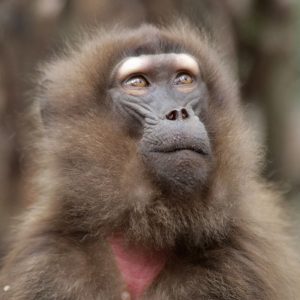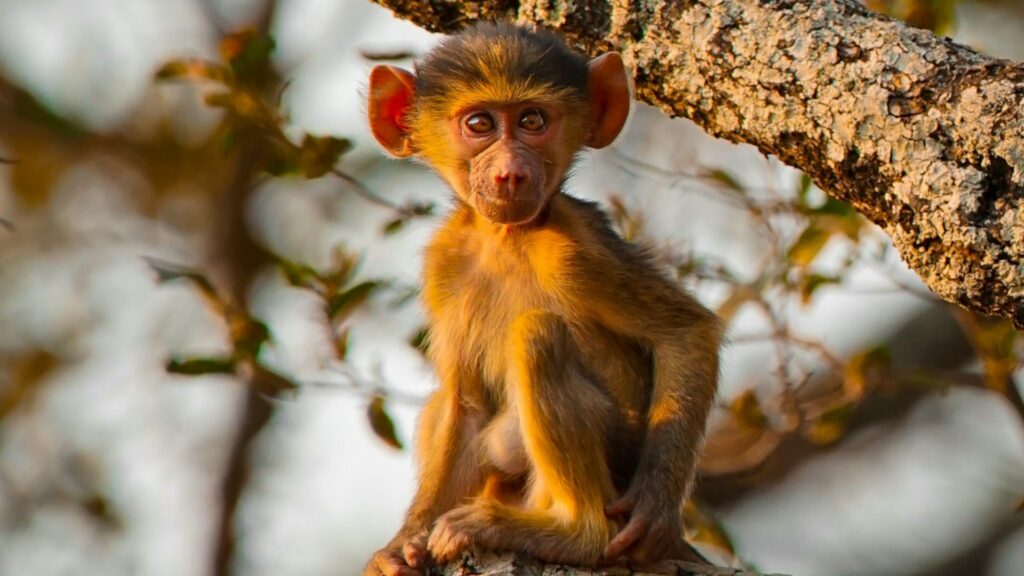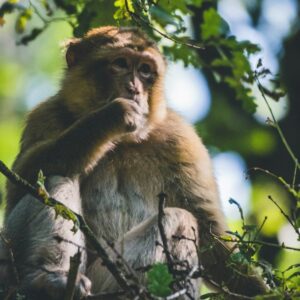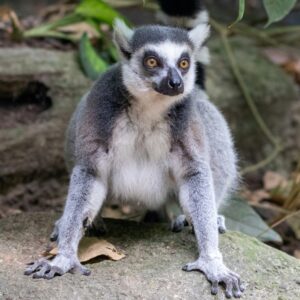Primates are a diverse group of mammals living across the world. Primates range in size from giant gorillas, to miniscule mouse lemurs. There are over 500 fascinating species of primates, each with unique characteristics and adaptations. Did you know some primates are our closest living relatives?! Find out more fun primate facts here.
1. There are 717 species and sub-species of primates
There are 527 known species of primates and 190 subspecies according to the IUCN Primate Specialist Group. This makes primates one of the most diverse groups of mammals on the planet!
New species are still being discovered in remote regions of the world. The newest species to be recorded by scientists is the Popa langur, found in Myanmar in 2020.
2. Not all primates are monkeys
Primates include apes, monkeys, and prosimians.
Apes (gorillas, chimpanzees, bonobos, orangutans, humans and gibbons) do not have tails, have larger brains relative to body size and are generally larger in body size compared to monkeys.
Monkeys usually have tails and are generally smaller than apes. They also have more species diversity than apes.
Prosimians (lemurs, tarsiers and bush babies) are the most ancient primates. They have smaller brains compared to apes and monkeys, and many are nocturnal, exhibiting different behaviours to monkeys and apes.
3. Primates live all over the world
Primates are native to Africa, Asia, and Central/South America.
Most live in tropical rainforests, but some survive in mountains, deserts, or even cities.
Barbary macaques are the only species living wild in Europe, found in Gibraltar, but their presence is a result of human introduction.
Apes in the wild only live in sub-Saharan Africa and East Asia.
4. There are two main types of monkeys
New World monkeys, or neotropical primates, live in the Americas and often have prehensile tails (meaning they can use their tails to grasp onto things like branches).
Old World monkeys live in Africa and Asia and are more closely related to apes.
Each species of monkey is unique, with differences in their physical features, behaviours, and even how many teeth they have. The names ‘New World’ and ‘Old World’ were coined by Europeans after they crossed the Atlantic to the Americas; a ‘new’ world to them.
5. Primates have big brains and sharp senses
Primates have unusually large brains, with scientists proposing many explanations for thisMost primates have forward-facing eyes and colour vision; their hands and feet are highly flexible, often with opposable thumbs.
6. Primates develop slowly, just like humans
They take longer to mature than other mammals of similar size. Great apes take the longest to develop, depending on their mothers to care for them care for years.
Newborn primates are very dependent on their parents or social group. Some primates, such as Javan gibbons, form family units like mother-father-child, with both parents providing infant care.
7. Most primates are omnivores, but not all

Geladas are endemic to Ethiopia
Most primates eat a wide range of foods, including leaves, fruit, nuts, insects, seeds, roots, eggs and meat. However, there are some exceptions with more specialised diets!
Geladas, endemic to Ethiopia, are ecological specialists, primarily consuming grasses and sedges (another grass-like plant). Born Free cares for geladas rescued from the illegal pet trade at our Ensessa Kotteh sanctuary in Ethiopia.
Tarsiers are fully carnivorous, only eating insects and small vertebrates.
Sportive lemurs, found in Madagascar, are specially adapted to process their leaf-based diet, with one of the lowest metabolic rates among mammals.
8. Some primates can use tools
Sticks, stones, and leaves are all used as tools by some species of primates to access food.
Western chimpanzees, bearded capuchins and long-tailed macaques have all been seen to use tools, usually stones, to crack open nuts.
9. Orangutans are often thought to be the smartest primate, except humans
Orangutans have been considered more intelligent than gorillas or chimpanzees in some studies. Orangutans share up to 97% of their DNA with humans, and they are known for their ability to problem-solve and learn new skills.
10. Mandrills have huge canines
The male mandrill, the largest living monkey, has shockingly long canines, capable of reaching 4.5cm long.
Their colourful faces with red and blue markings make them one of the most recognisable primates – think of Rafiki from the Lion King!
There is a big size difference between male and female mandrills. They are the most dimorphic (size difference between sexes) of all primate species.
11. The Myanmar Snub-Nosed Monkey rain
Snub-nosed monkeys have upturned nostrils, which rainwater can easily enter, causing them to sneeze, according to local people. To prevent this, they tuck their heads between their knees.
Myanmar snub-nosed monkeys were only officially recorded by scientists in 2010.
12. Lemurs are only found in Madagascar
There are over 100 species of living lemurs today.
Madame Berthe’s mouse lemur is the world’s smallest primate, with an average body length of just 9.2cm.
Blue-eyed black lemurs are one of the only primates, along with humans, to commonly have blue eyes.
13. Most primates are very social
Many primates live in groups or troops, which may be male- or female-dominated.
Some solitary primates are galagos (bush babies), lorises, tarsiers and some lemurs. Orangutans are often considered solitary, but more recent research shows they aren’t as solitary as initially thought.
Some species of primate pair-bond. This means that males and females form long-lasting bonds and share responsibilities, including caring for their offspring, guarding territory and foraging. Titi monkeys and gibbons are two species which commonly pair-bond.
14. Many Primates Are Threatened by Extinction
Nearly 70% of species and subspecies of primates are considered threatened by the IUCN.
Of these, the majority are Endangered or Critically Endangered. Habitat destruction, hunting, and the illegal pet trade are among the major threats to primates across the world.






